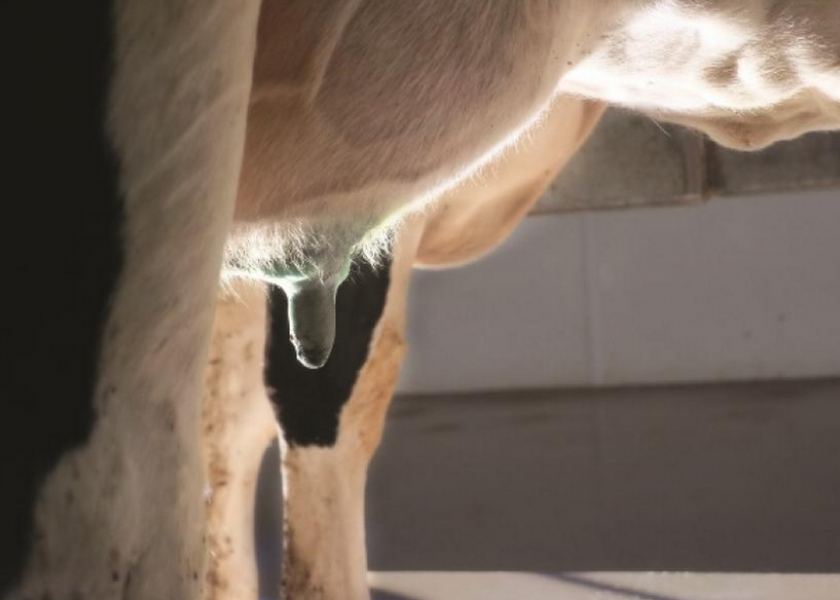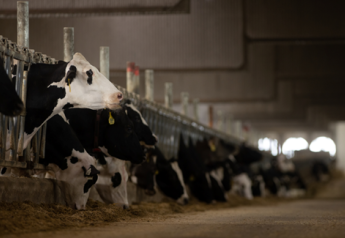Use Teat Disinfection to Protect Against Contagious Pathogens

The rate of new udder infection is related to the number of mastitis-causing pathogens on teat ends. Disinfecting teats with a germicidal agent immediately after milking kills most of the pathogens on teats. This in turn reduces the chance of those pathogens getting into the udder.
Postmilking teat disinfection is especially effective against the contagious pathogens Staphylococcus aureus and Streptococcus agalactiae. While milking can spread any type of mastitis pathogen, these two pathogens in particular spread from cow to cow during the milking process.
Postmilking teat disinfection is less effective in reducing the new infection rate of “environmental” pathogens such as coliforms and Streptococcus species other than Streptococcus agalactiae.
Control of environmental pathogens requires management practices including maintaining cows in a clean, dry environment; good premilking hygiene, including premilking teat disinfection and thoroughly drying teats; and using functionally adequate milking machines. Milkers should continue postmilking teat disinfecting as a routine part of milking procedures, even if Streptococcus agalactiae has been eliminated and somatic cell counts are low.
What to Expect
More than 50% of new udder infections can be prevented by disinfecting teats with an effective product immediately after every milking. Teat disinfection does not affect existing infections. Existing infections are best eliminated by dry cow treatment and culling chronically infected cows.
Prevention of new infections by teat disinfection and elimination of existing mastitis cases reduce the level of mastitis in a dairy herd year by year. Improvements, such as decreased cases of clinical mastitis and/or lowered herd somatic cell counts, generally can be observed within a few months. Do not expect miracles overnight!
How to Apply
Postmilking teat disinfectants can be applied either by dipping or spraying. Either method is acceptable, if done in a manner that thoroughly covers the entire teat. Care should be taken to ensure that all four teats are covered. The disinfectant should be applied immediately after every milking.
Proper Handling
Store teat disinfectants in cool, dry areas. Do not allow disinfectants to freeze! Keep containers closed to prevent contamination, and do not use after the expiration date. Do not assume that teat disinfectants will kill all pathogens. Some pathogens can survive in disinfectant under some conditions.
Follow label instructions for use. Use teat disinfectants at the recommended concentration. Do not dilute unless indicated on the label. If dilution is necessary, be sure that water quality standards (bacteria, pH, hardness, etc.) are met. Use a clean container for diluting, and thoroughly mix the final product.
Disinfectant cups should be emptied and cleaned as part of the routine wash-up after each milking or if they become contaminated during milking. Never pour used disinfectant back into the original container.
What Products to Use
Good teat disinfectants should have efficacy against the major mastitis pathogens, be economical, easy to apply, and should maintain or promote good skin condition. Both traditional and barrier types of disinfectants are available. Whatever type is chosen, the product should have documented efficacy against all the major contagious mastitis pathogens.
Use only products that are: 1) listed with the Food and Drug Administration (FDA) and 2) shown to effectively reduce infection rate by controlled research. The FDA regulates teat disinfectants as over-the-counter (OTC) drugs. However, the FDA does not require proof of effectiveness for labeling. Specific teat disinfectants have been studied in controlled research, but imitations are readily available, and minor formulation changes often reduce effectiveness.
Dairy producers and veterinarians should demand information from the manufacturer on compliance with FDA regulations and results of controlled research studies showing efficacy. Another source of information concerning teat disinfectant efficacy is the Summary of Peer-Reviewed Publications on Efficacy of Premilking and Postmilking Teat Disinfectants Published Since 1980 made available and updated annually by the National Mastitis Council (NMC). The summary of peer-reviewed publications is not exhaustive, and new findings may be reported between publications of the list.
How Are Teat Disinfectants Tested?
The National Mastitis Council (NMC) recommends two methods of testing teat disinfectants. Protocols for Experimental Challenge and Natural Exposure are described briefly below:
• Experimental Challenge evaluates the ability of a teat disinfectant to prevent infections in dairy cows under conditions of experimental exposure to mastitis pathogens. This protocol determines effectiveness under experimental conditions only.
• Natural Exposure evaluates ability of a teat disinfectant to prevent infection in dairy cows under commercial dairy practices. This protocol determines effectiveness under natural conditions.
The protocols are available from NMC on request. Dairy producers should educate themselves about the products that they are considering. They should inquire as to the types of studies that have been conducted, the pathogens that the product is designed to control, and the efficacy results.
What about Teat Disinfecting in Cold Weather?
During periods of extreme cold or when wind chill is significant, special precautions should be taken to avoid chapped and frozen teats. Cold weather recommendations include:
1. Teats should be dry before turning cows out into cold weather.
2. When teats are disinfected after milking, allow 30 seconds contact time, and blot off any excess disinfectant with a single-service towel.
3. Warm teat disinfectants in cold conditions to reduce drying time.
4. Provide windbreaks in outside areas for cows.
5. Monitor fresh cows with swollen udders and teats since they are more susceptible to chapped and frozen teats.
In Summary
• More than 50% of new udder infections can be prevented with proper teat disinfection.
• Apply teat disinfectant immediately after milking.
• Ensure that disinfectant thoroughly covers the entire surface of all teats.
• Handle teat disinfectants properly.
• Demand information about the teat disinfectant you plan to use.
Teat disinfecting is an important part of a mastitis control plan. In addition to disinfecting teats immediately after milking, using good milking and environmental management procedures, using properly functioning milking equipment, treating every quarter of every cow at dry off, identifying and treating or managing clinical cases promptly, and culling chronically infected cows should provide an effective mastitis control plan for the dairy.
Biosecurity Preparedness Needed For FMD
Scientists Identify Proteins in Bacteria Associated with BRD







